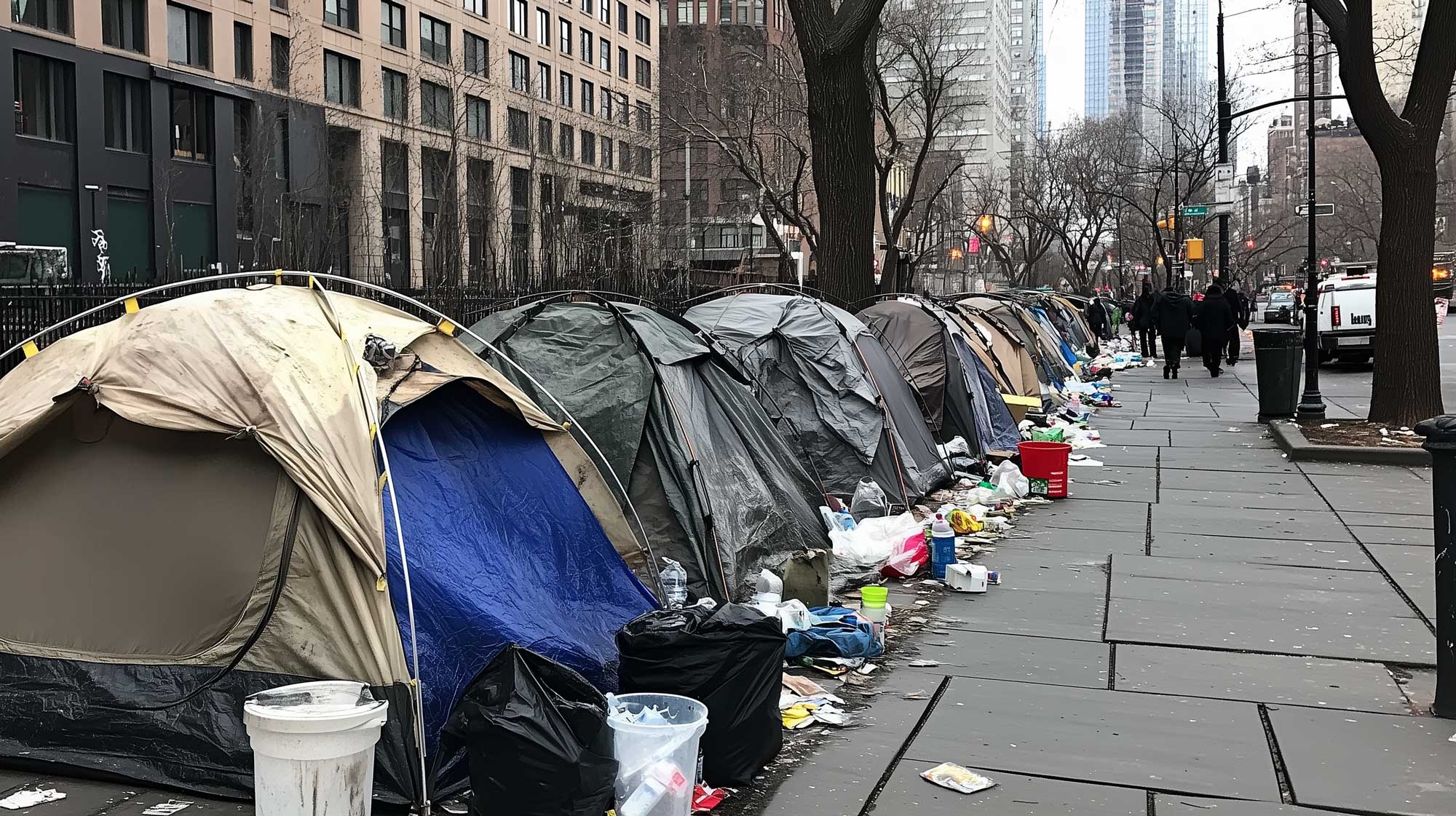
What Cities Can Do Today to Address Homelessness Better
Awareness is rising at the state and municipal levels that current efforts to reduce homelessness are not working. The evidence is clear—more people, filth, and lawlessness on the street.
As complaints and concerns from citizens pour into the offices of state legislators and city council members, more states and cities are considering how to constructively address the issue. On the one hand, plans and strategies have been finalized, funds have been allocated, and coordination systems established. On the other hand, improved street conditions, more housing, and less crime seem out of reach. Current plans, strategies, funding, and coordination aren’t having the desired effect. However, there is a lot that cities can do today to effectively reduce homelessness.
In many states, new laws are being passed banning public camping, reviewing program budgets and outcomes, and establishing drug-free homeless service zones. A number of states have passed resolutions encouraging reforms to the U.S. Department of Housing and Urban Development’s (HUD) homelessness program to give states flexibility in implementing effective solutions.
One key area of interest is tracking where money for homelessness is actually going and whether it is helping or being wasted. In Los Angeles, a federal lawsuit resulted in a third-party audit that demonstrated poor financial management, lack of programmatic performance, and a system in disarray. Things are so bad that the Department of Justice has launched a criminal task force to investigate waste, fraud, and abuse in LA.
The challenge for cities is how to implement relatively discreet, low-cost initiatives that don’t run afoul of state and regional plans and strategies. Most of the opportunity is at the street level, well within the jurisdiction of municipalities and outside of the realm of housing programs.
Here are a number of ideas to make quick impacts, raise awareness of successes, and address failures.
1. Collect Street-Level and Programmatic Data and Information
One of the biggest challenges for city-level decision-makers is getting good information they can use to make sound choices. There is a striking lack of information on how many people are on the street, where they are, what they need, what strategies work, and how they are being helped.
This is because of the extreme emphasis from the federal government and homelessness advocates on housing. Housing, however, is the number one most expensive alternative and its effectiveness is limited. Most cities, except the largest urban centers with large tax bases, are unable to scale housing that results in a reduction in the number of people living on the street.
In order to utilize scarce resources such as housing, a robust and reliable data collection and reporting system is required. The federal government requires regional homelessness consortia to employ a Homelessness Management Information System (HMIS). However, HUD is the customer for HMIS, not local decision makers, and HMIS data is often unusable to determine municipal initiatives.
2. Utilize Outreach Teams and Business Improvement District Ambassadors
Business Investment Districts (BIDs) and other downtown groups often utilize ambassadors who patrol the streets within their boundaries and offer information and help to anyone. Salt Lake City’s Downtown Alliance employs ambassadors who “ensure everyone is welcome and safe downtown. They are on the streets daily helping people find their way, assisting businesses, and referring people in need to qualified service providers.”
The ambassador program collects information about engagements with homeless people. They track where they engage the homeless and what they offer in terms of assistance, material needs, and referrals. By collecting and tracking this data, Cities can get up-to-date information on a bi-weekly or monthly basis about the size and composition of the homeless population on the street. Data can determine the scale of homelessness, hotspots, matches with complaints and crime reports, as well as how, who, and what outcomes came from referrals to shelters, housing navigators, and other services.
The Downtown San Diego Partnership Clean & Safe Program collects similar information and has ambassadors indicate on simple maps where and how many tents, individuals, and encampments are located within the Partnership’s service boundaries. This provides a useful census and demonstrates how things change on the streets over time and with interventions.
Creating uniform data collection methods and expanding and organizing teams to include homeless outreach workers and emergency responders will capture valuable data to help homeless people and the communities.
3. Compel Homeless Service Organization Transparency by Including Reporting in Permitting
Conditional use permits (CUPs) allow property owners to use their land in a way that is not typically permitted under the existing zoning regulations, but only if specific conditions are met. Most non-profit organizations, because they offer unique services, are permitted to operate with a municipality under CUPs.
Cities negotiate CUPs with nonprofit providers, including how they utilize security, distribute food, manage parking, and other matters. Cities should include in CUPs that nonprofit homelessness organizations report the population served, numbers served, and service outcomes and referrals. These data are critical to better understand how well homelessness service organizations are meeting the needs of homeless people and assisting the community.
4. Request That Police Departments Provide Data
Increasingly, law enforcement is the entity closest to what is happening with people living on the street. The creation of Homeless Outreach Teams and Crisis Intervention Teams provides opportunities for cities to understand more about the size and characteristics of the homeless population. This could include acuity levels and information on repeat contacts. It is important to have data anonymized and aggregated to protect the privacy of individuals. The Fontana, California police department was collecting data on homeless people and their locations, sex offender status, arrest history, and criminal records of homeless persons to better understand the risks associated with encampments and homelessness.
5. Create Baselines To Analyze the Impact of Interventions
Once baseline data is established from monthly censuses and other inputs, some patterns should emerge. For example, it is well known that homeless people move between Las Vegas and Salt Lake City at different times of year. Salt Lake sees a decrease in the homeless population during the winter when homeless people relocate to Las Vegas, and then it increases when they come back for the summer. Understanding these seasonal fluctuations can help cities prepare and plan—and can also help in the analysis of interventions. Introducing initiatives, such as a limited camping ban, a small, safe parking area, or a safe camping area, should have an impact on the number of people living on the street. Other interventions, such as a campaign to engage unsheltered people and promote referrals, or a program to promote crime prevention through environmental design, such as installing lighting, cutting back foliage, etc., to create safer environments, could have similar impacts on the baseline.
6. Develop Discrete Innovations
Part of the challenge of addressing homelessness is understanding how to make an impact without having to appropriate large sums of public money. For many small-to-medium-sized cities, developing hundreds of units of permanent supportive housing is simply unrealistic because of its high costs.
It’s important to avoid Continuum of Care programs because they are so complex and costly. Instead, focus on what can be done at the local, even district, levels. While it is a fond notion to put every effort into creating more housing and getting people into housing, capacity and bureaucratic challenges leave local decision-makers wanting to make an impact without a huge price tag impacting the budget.
7. Place Homelessness Department or CoC Personnel in City Council Offices
One of the most time-consuming challenges City Council members face is fielding reports and complaints about homeless people. Often, city council offices are attempting to case manage or refer people to the right agency, adding another costly step to an already-complicated process.
To address this challenge, create a space to host a representative of the city homelessness department or continuum of care’s outreach or navigation functions in City Council field offices. These individuals often have more experience and knowledge in addressing homelessness and navigating the referral and placement process.
They should keep metrics of calls, referrals, and actions made by these individuals so that decision makers understand the gaps and complications of placing homeless people into housing. With the right information, decision makers can focus on improving the system, while administrators can focus on implementing the system.
8. Invite the Community to Understand the System
Solutions often come from the bottom up, they’re not imposed from the top down. And no one is closer or more invested in improving their communities as residents and business owners. Inviting these important constituents to identify problems and create action plans will empower them and provide first-hand experience in seeing the bottle necks and bureaucracy. Additionally, it is important to invite taxpayers to see what their taxes pay for. It may be beneficial to include law enforcement representatives so that citizens can understand what is going on at the street level.
To avoid biased information and rosy scenarios, do not include nonprofit organizations that receive public money to address homelessness. These groups receive little oversight or critical performance reviews, often represent their own interests, and are at odds with the interests of residents and business owners. Instead, form citizen accountability groups and put performance review boards in place so that taxpayers can hold these groups accountable.
9. Regulate Events To Increase Opportunities for Assistance
Citizen groups, driven by compassion, often engage in events intended to support or provide resources to homeless people. These events include clothing drives or public events to feed the hungry. Some even drop off oversized items such as couches or other furniture in a desire to make life on the street more comfortable.
While these events have the best of intentions, they often are illegal or lack the appropriate regulation to do the most good. In Oceanside, CA, police discourage individuals and groups from public feeding events and dropping off boxes of sandwiches because seagulls have learned to get there first. These birds make huge messes, leaving bits of food, plastic wrap, and trash all over.
To assist groups in engaging in acts of compassion, communities must require individuals and organizations participating in public feedings to apply for permits, only serve packaged foods or foods prepared in commercial kitchens, and commit to specific dates and times to conduct feedings. They must also ensure that housing navigators, public health, mental health, and addiction recovery services are present along with law enforcement at each of these events that feed the homeless or hungry. Communities should require that civic and religious groups holding these events coordinate with county, law enforcement, and homeless services providers so that referrals and engagement can occur.
10. Connect With Certified Community Behavioral Health Clinic Providers if Available
One of the greatest resources made available by the federal government is the expansion of certified behavioral health clinics. These clinics are required to provide mental illness and addiction treatment, and 24/7 crisis intervention services. It’s important to understand where these clinics exist in an area and see if there are ways to refer homeless people to them. Creating a referral pipeline is often the quickest way to get people with significant behavioral health needs the help they deserve.
11. Create a Non-Profit Coalition Separate from the Continuum of Care
Continuums of Care channel millions of dollars into communities to address homelessness and are supposed to serve as the main funding, coordinating, and planning entity for their communities. Its funding, however, comes with significant strings attached; it’s no secret that CoCs are overly bureaucratic, restrictive, and ineffective in reducing homelessness.
Because of this, some communities are forming separate coalitions made up of organizations that are focused on outcomes and effectiveness. These groups identify a few common principles to rally around and work as true coalitions to do whatever it takes to get people off the street and into housing and help. They include high-barrier, low-barrier, faith-based, secular, privately funded, and publicly funded organizations that have had it with the inflexible, controlling status quo.
Creating a coalition can be as easy as disaffected nonprofit organizations that have quickly learned the challenges of being a part of the CoC. The City of Kansas City, MO, created Zero KC to overcome the problems of the CoC and hosts a couple of hundred programs committed to its core principles. When progress isn’t being made, one can often find a way to make it. Local governments have opportunities to address homelessness that are simple, effective, and inexpensive. In short, they are better than the status quo. Whether it’s improved data collection, establishing referral pipelines, event coordination and management, or creating feedback loops from constituents, there is plenty of room for innovation. The key is to avoid funding and programs that increase bureaucracy and have failed to improve the conditions on the street.

Stay Informed
Sign up to receive updates about our fight for policies at the state level that restore liberty through transparency and accountability in American governance.
